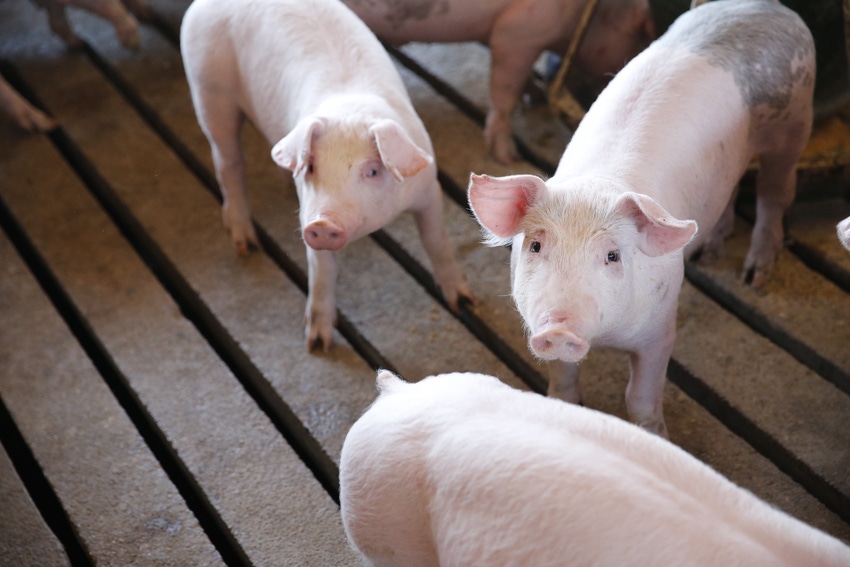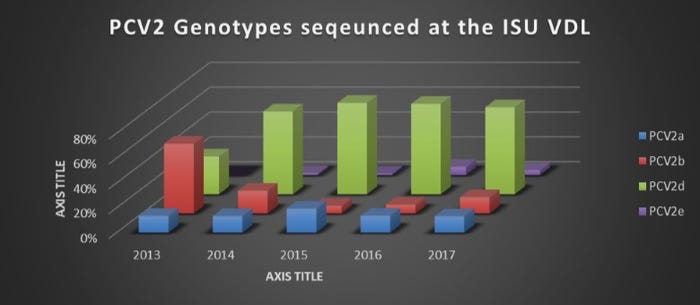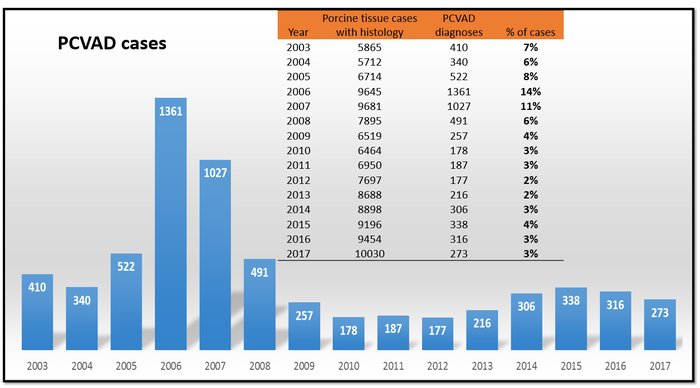Darin Madson, DVM, outlines future considerations for the ever-changing virus — porcine circovirus type 2.
May 16, 2018

Porcine circovirus type 2 is a common virus of pigs found throughout the world. It may not be a new virus challenge for pork producers and swine veterinarians, but it remains a constant challenge. PCV2 ranks among the top three infectious agents in the swine industry, causing losses in non-vaccinated herds from $3 to $22 per pig.1
In the growing pig, PCV2 impacts the animal’s ability to thrive, resulting in post-weaning multisystemic wasting syndrome. But the greatest risk comes in the form of secondary infections — particularly respiratory diseases that combine to produce porcine circovirus associated disease in pigs of any age, as well as reproductive failure in the breeding herd. Diarrhea and porcine dermatitis and nephropathy syndrome also can develop in infected pigs.
With PCV2, some things are certain:
• The virus is everywhere. If there are pigs on a site, it’s essentially guaranteed that some version of PCV2 is present at some level.
• It’s an extremely hardy virus — difficult to kill with disinfectants and resistant to heat.
• There is no direct treatment for PCV2, only to address secondary infections. Vaccination is the most effective tool.
• The virus continuously mutates over time. Exactly when or how future mutations will occur is less clear.
The ever-changing virus
“PCV2 is among the highest-mutating DNA virus in animals,” says Darin Madson, DVM, Ph.D., veterinary diagnostician at Iowa State University. “Also, PCV2 is a group of viruses, and you can have multiple viruses within a genotype.”
Today, there are four PCV2 genotypes in the United States — PCV2a, b, d and e. Globally, two additional genotypes have been identified — PCV2c and f.
Madson explains that PCV2a surfaced as a production issue in the US in the early 2000s, spiking in 2005. Around that time, the virus shifted and PCV2b emerged as the prominent genotype. There was another major shift around 2012 when PCV2d — a genotype first described as “mutant 2b” — surfaced and started to gain dominance.
Although his experience is with the cases identified at ISU’s Veterinary Diagnostic Laboratory, Madson believes these shifts are an accurate representation of what’s occurring in the field. “We do get cases from all over the Midwest,” he notes. “Even though there are 50 states in the U.S., in the pig world it’s essentially one big state.”
Figure 1 shows a five-year snapshot of the PCV2 virus’ evolution in the United States, as illustrated by ISU VDL cases.
Figure 1. Prevalence of PCV2 genotypes in US swine herds, 2013-2017

Source: Madson, Iowa State University Veterinary Diagnostic Laboratory
The ISU VDL results show that PCV2d has now become the most prevalent version, accounting for 70% of genotypes sequenced, up from 30% in 2013. PCV2b peaked at 56.13% in 2013, began to decline, but has recently trended up a bit to 13.08%. PCV2a has changed the least during the past five years, remaining around 13%.
Complicating matters further is that two production sites could both have PCV2b but actually be dealing with different viruses within that genotype. A production site also could have multiple PCV2 genotypes — say, PCV2a and PCV2b — on the same site. This can be exacerbated if pigs come from multiple sources.
“Occasionally, those genotypes can get together and make their own virus. They also can make secondary infections worse, depending on the situation,” Madson notes.
Vaccines are the tool of choice
Essentially all pigs in the United States are vaccinated for PCV2 today because the alternative would be devastating to their productivity and well-being. The good news is that the vaccines are highly effective, Madson points out. The key is to focus on the quality of the vaccination — that all of the pigs are vaccinated with the right dose at the right time.
“If you miss pigs during vaccination or adjust the dose, it gives PCV2 an opening to replicate at a higher level,” Madson says. “Proper vaccination also diminishes shedding and the viral load in the environment, which minimizes the opportunity for mutation and helps to control the virus overall.” Of course, that’s important to the pork industry as a whole.
Nearly 100% of the market hogs are vaccinated for PCV2 at a young age. Replacement gilts are vaccinated similarly, receiving a booster once they are selected or are ready to enter the sow farm. But sow re-vaccinations are less commonplace — about 10% to 20% of U.S. sows, Madson estimates.
Is that a missed opportunity? “That’s for the producer and veterinarian to decide,” he adds. “It depends on the herd’s goals, downstream flows and the farm’s risk level.”
But unvaccinated animals expand the virus’ opportunity to change. And science has shown that there is an increased mutation rate in non-vaccinated herds.2
While it’s true that DNA viruses are more responsive to vaccines, because they don’t typically mutate at a high rate, it’s also true that PCV2’s ability to mutate is an exception to the rule. That means producers and veterinarians need to keep an eye on trends and genotype shifts to understand how PCV2 is changing. Today, that involves monitoring the rise in PCV2b and PCV2d prevalence and the decline in PCV2a cases.
Table 1: PCV2 genotype relatability

Source: Bao et al. 2017
For example, as shown in Table 1, PCV2b and PCV2d are more closely related than PCV2a and PCV2d. Based on genetic sequencing and the evolutionary history, PCV2a and PCV2b are about 93% identical while PCV2b and PCV2d are 95% identical.3
Again, this shows that the viruses are very different, and monitoring these differences provides insight regarding vaccine efficacy.
On the farm, the natural tendency is to stick with the same vaccine and immunization strategies until a problem surfaces. But there’s benefit in periodically reviewing the PCV2 vaccine program and immunization timing and procedures.
“If a producer thinks there are problems, he or she needs to review the vaccination program with the herd veterinarian to come up with strategies to get better protection,” Madson notes. “That might include what they immunize against or how they immunize.”
He emphasizes that the commercial vaccines continue to be effective. “Everything is working well right now, but that doesn’t mean that will always be the case. We need to understand that and not get complacent.”
What causes PCV2 to mutate, beyond a virus’ natural need to survive, is unknown. “Whether the next shift will be in seven years, 10 years or more is anyone’s guess,” Madson adds. “I can only speculate that it will mutate again as it has in the past.”
A word about PVC2 diagnostics
Something of a hot button for Madson related to PCV2 diagnostics is the industry’s unwavering commitment to polymerase chain reaction tests. “PCR is great for viruses you’re not supposed to have, such as porcine reproductive and respiratory syndrome, but when it comes to PCV2, it’s a different story,” Madson says. While PCR allows the identification of minute amounts of a pathogen, it’s less useful with a virus such as PCV2 that’s everywhere. Mere detection of PCV2 does not necessarily correlate with disease or indicate vaccine inefficacy.
However, PCR can help determine the best time to vaccinate or booster pigs, and sequencing offers insights into genetic shifts.
For PCV2, the real question becomes, are you diagnosing infection or disease? “PCV2 infection is going to be there at some level — it just is,” Madson says. The more important action is to diagnose any associated disease, which requires checking for clinical signs and microscopic lesions and determining whether the virus is at a level that will cause problems within the herd.
“What else are you seeing? What’s the herd history?” he adds. “You have to put all of the pieces of the diagnostic puzzle together in order to take effective action.”
Madson points to Figure 2, illustrating that PCVAD cases peaked in 2006-07, began to decline and have held pretty steady since about 2009.
Figure 2: PCV2 vaccination limits PCVAD cases

Source: Madson, Iowa State University Veterinary Diagnostic Laboratory
“This table shows that even though the virus is shifting, the pigs are telling us that our prevention steps are working,” he adds. “Essentially 100% of U.S. pigs are vaccinated, and these programs are providing an umbrella for the US swine industry against PCV2. There may be room for individual tweaks, but it’s still working really well.”
The question is, will that always be the case?
Source: Darin Madson, DVM Ph.D., is a veterinary diagnostician at Iowa State University. The interview and information for this article were made possible through a coordinated effort with Pig Health Today and ISU College of Veterinary Medicine.
1 Gillespie J, et al. Porcine circovirus type 2 and porcine circovirus-associated disease. J Vet Intern Med. 2009;23:1151-1163.
2Ssemadaali MA, et al. Genetic diversity of porcine circovirus type 2 and implications for detection and control. Vet Sci. 2015;103:179-186.
3 Xiao CT, et al. Global molecular genetic analysis of porcine circovirus type 2 (PCV2) sequences confirms the presence of four main PCV2 genotypes and reveals a rapid increase of PCV2d. J General Virol. 2015; 96:1830-1841.
You May Also Like



